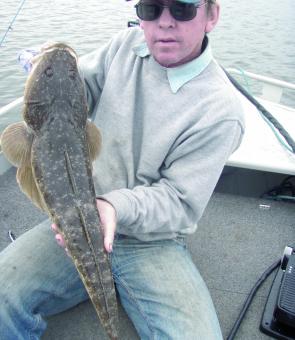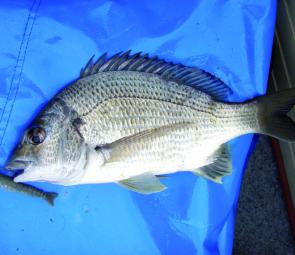I think it’s April in the Northern Hemisphere that they say ‘comes in like a lion and out like a lamb’ but August is usually a bit like that around here – it starts out with a wintry blast but often ends up warm and redolent with spring.
And it’s not only the temperature that changes in August. The heady winter action around the rocks, beaches and lower estuaries gradually tames down this month as fish move farther upstream, concentrating on food rather than migration or breeding.
Blackfish, bream, jewfish and increasing numbers of flathead will begin to head up the rivers, exploring areas that they haven’t seen for several months since their own seasonal instincts and walls of floodwater drove them down to the ocean.
They’ll be following schools of young baitfish, like fingerlings from the autumn mullet spawn and the next generation of herrings, as well as a new recruitment of school prawns and shrimp, all taking advantage of ever-expanding areas of higher-salinity habitat.
The cooler weather during the heavy rains meant that the drain chemistry wasn’t as extensive so fish kills were only minimal this year. That’s just as well, because numbers of bream, jewfish and whiting were beginning to recover fairly reasonably.
We’ll be hoping that the noted decline in flathead numbers over the past year or so picks up a fair bit this season and next.
I’m going to go out on a limb and say the drop in flatties probably could have something to do with the slaughter of over 100 big female fish during the Christmas holidays around three or four years ago. Local tackle shops were weighing in fish over 4kg every day for the local newspaper comp, which, fortunately, now doesn’t encourage such stupidity.
The beaches also change character a bit this month, going from centres of red-hot action day and night to more subdued strips of sand, sometimes with the first inklings of the onshore afternoon sea breezes that will become so prevalent over coming months.
There’ll still be the odd school of tailor hurrying north for their spawning run but they’ll most likely be smaller fish, and the jew, bream and flathead on the beaches will be fewer.
Snapper, on the other hand, will be hitting their straps as the schools gather together for spawning over the inshore gravel patches and shell grit beds. These fish have been spawning for the last few weeks or more and, as ‘serial spawners’, can be expected to keep at it over the next month or so, depending on conditions.
Given that DPI Fisheries data indicates that only 1% of the snapper population is estimated to reach 10 years old (and anywhere from 40-65cm long), maybe we should go easy on the reds while they’re spawning to ensure there might be a few more of them to catch in another year or two.
Anyone who fishes near the Lennox Head town area should grab a copy of the Cape Byron Marine Park guide.
A number of anglers have been busted and fined for fishing around the Moat/Bream Hole area at the front of town. Formerly a popular beach fishing venue at high tide, especially after dark in winter when big tailor and jewfish were common captures, the area is now a sanctuary zone entirely off limits to your average family fisho.
Marine Park Manager, Andrew Page, says that while most of the park is open to fishing, it’s prohibited in the Moat/Bream Hole area. The area immediately adjacent to the Lennox Head boardwalk is a special-purpose zone open to fishing only for people with a disability under a marine parks permit.
Facts
TEARING UP THE BLUE FRINGE
The minute you turned into the car park at the Evans Head RSL it was obvious that the fishos were not happy. The Evans Head Marine Management Committee had convened the meeting and the auditorium at the RSL was bursting at the seams.
Master of Ceremonies for the evening was Lismore tackle store owner Lindsay Doust, who estimated close to 500 people had turned up.
The chairman of the committee, local veterinarian Rod Blake kicked things off with a very professional presentation of what we can expect if the Bundjalung Marine Park proposed by the National Parks Association goes ahead.
He pointed out that the document Torn Blue Fringe had already been placed in the hands of the Marine Parks Authority, even though DPI Fisheries had said that NSW did not need another marine park and that this proposal lacked adequate scientific evidence.
Rod Blake also pointed out that the Greens had shown that they can have a serious influence on elections by the results of the last Queensland election. As a result of payback for distribution of preferences Premier Anna Bligh had announced new marine parks on Cape York affecting major rivers without consultation of stakeholders. So it would be unrealistic not to expect the same in NSW at the next State elections. In other words, political marine parks.
The stated priorities for the NSW green lobby group National Parks Association are for a Sydney marine park and another for Twofold Bay. However, if these become an electoral liability to the Government, the obvious next step is the NSW Mid and Far North Coast.
Evans Head, it was pointed out, was not in a position to try alternative attractions to fishing as a means of attracting tourism dollars. “People come here for the fishing,” Dr Blake said, “nothing else.”
The proposed park was to stretch from Snapper Rock in the north to the South Wall at Yamba. The core of this park is expected to be North Evans Reef, AKA Kahors, a spot well known to local offshore fishers.
Other speakers included professional fishers, local business people, and NSW Fishing Monthly Editor Tony Zann, who advocated individual, controlled lobbying of politicians.
This meeting was a coming together of the different user groups of a small but vocal community. Those present included tow-in surfers, spearfishers, recreational and pro fishers and the local fish Co-Op, coming together to voice their opposition to a common threat to a way of life, an income and something as Australian as the right to go and catch a fish, even if you end up putting it back.
The meeting voted unanimously to oppose the creation of a marine park between Evans Head and Iluka. For further information call the secretary of the Evans Head Marine Management Committee, Barry Hayward, on 02 6682 5801.
– John Denman

Flathead should become more regular catches in the estuary this month.

The roughest weather for 20 years has eroded beaches around Evans Head almost back to the underlying coffee rock in places.

Bream and shrimp lures will become more synonymous over coming months.




